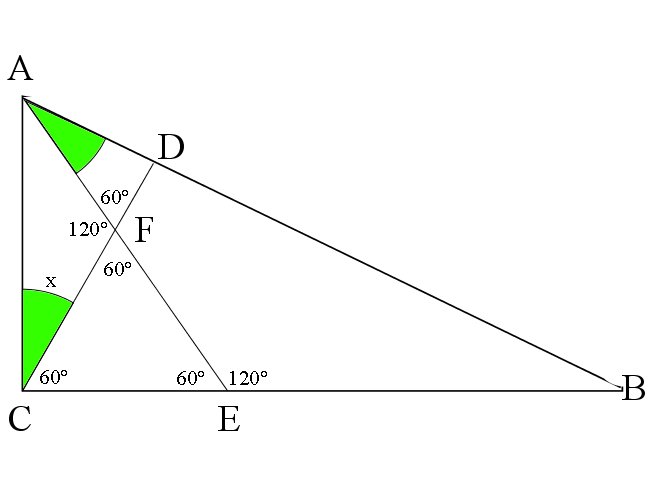2010 AMC 12A Problems/Problem 8
Contents
[hide]Problem
Triangle ![]() has
has ![]() . Let
. Let ![]() and
and ![]() be on
be on ![]() and
and ![]() , respectively, such that
, respectively, such that ![]() . Let
. Let ![]() be the intersection of segments
be the intersection of segments ![]() and
and ![]() , and suppose that
, and suppose that ![]() is equilateral. What is
is equilateral. What is ![]() ?
?
![]()
Solution 1

Let ![]() .
.

Since ![]() and the angle between the hypotenuse and the shorter side is
and the angle between the hypotenuse and the shorter side is ![]() , triangle
, triangle ![]() is a
is a ![]() triangle, so
triangle, so ![]() .
.
Solution 2(Trig and Angle Chasing)
Let ![]() Let
Let ![]() Because
Because ![]() is equilateral, we get
is equilateral, we get ![]() , so
, so ![]()
Because ![]() is equilateral, we get
is equilateral, we get ![]() .
.
Angles ![]() and
and ![]() are vertical, so
are vertical, so ![]() .
.
By triangle ![]() , we have
, we have ![]() , and because of line
, and because of line ![]() , we have
, we have ![]() .
.
Because Of line ![]() , we have
, we have ![]() , and by line
, and by line ![]() , we have
, we have ![]() .
.
By quadrilateral ![]() , we have
, we have ![]() .
.
By the Law of Sines:
![]()
By the sine addition formula(![]() ):
):
![]()
Because cosine is an even function, and sine is an odd function, we have ![]()
We know that ![]() , and
, and ![]() , hence
, hence
![]()
The only value of ![]() that satisfies
that satisfies ![]() (because
(because ![]() is an angle of the triangle) is
is an angle of the triangle) is ![]() . We seek to find
. We seek to find ![]() , which as we found before is
, which as we found before is ![]() , which is
, which is ![]() . The answer is
. The answer is ![]()
-vsamc
Solution 3 (Similar Triangles)
Notice that ![]() and
and ![]() . Hence, triangle AEB is similar to triangle CFA. Since
. Hence, triangle AEB is similar to triangle CFA. Since ![]() ,
, ![]() , as triangle CFE is equilateral. Therefore,
, as triangle CFE is equilateral. Therefore, ![]() , and since
, and since ![]() ,
, ![]() . Thus, the measure of
. Thus, the measure of ![]() equals to
equals to ![]() -HarryW
-HarryW
Solution 4
Notice that ![]() (by AA Similarity.) Since the corresponding angles of a pair of similar triangles are congruent, we have
(by AA Similarity.) Since the corresponding angles of a pair of similar triangles are congruent, we have ![]() Since
Since ![]() and
and ![]() we have that
we have that ![]() is congruent by SAS to a
is congruent by SAS to a ![]() right triangle, which gives the answer
right triangle, which gives the answer ![]() .
~clever14710owl
.
~clever14710owl
Video Solution by the Beauty of Math
https://youtu.be/kU70k1-ONgM?t=785
Video Solution by OmegaLearn
https://youtu.be/O_o_-yjGrOU?t=58
~ pi_is_3.14
See also
| 2010 AMC 10A (Problems • Answer Key • Resources) | ||
| Preceded by Problem 13 |
Followed by Problem 15 | |
| 1 • 2 • 3 • 4 • 5 • 6 • 7 • 8 • 9 • 10 • 11 • 12 • 13 • 14 • 15 • 16 • 17 • 18 • 19 • 20 • 21 • 22 • 23 • 24 • 25 | ||
| All AMC 10 Problems and Solutions | ||
| 2010 AMC 12A (Problems • Answer Key • Resources) | |
| Preceded by Problem 7 |
Followed by Problem 9 |
| 1 • 2 • 3 • 4 • 5 • 6 • 7 • 8 • 9 • 10 • 11 • 12 • 13 • 14 • 15 • 16 • 17 • 18 • 19 • 20 • 21 • 22 • 23 • 24 • 25 | |
| All AMC 12 Problems and Solutions | |
The problems on this page are copyrighted by the Mathematical Association of America's American Mathematics Competitions. ![]()









